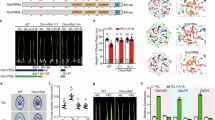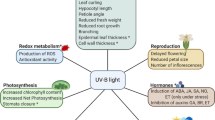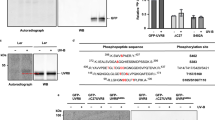Abstract
UV-B (280-315 nm) is an integral part of solar radiation and can act either as a stress inducer or as a developmental signal. In recent years, increasing attention has been paid to the low-fluence UV-B-induced photomorphogenic response and several key players in this response have been identified, which include UVR8 (a UV-B-specific photoreceptor), COP1 (a WD40-repeat-containing RING finger protein), HY5 (a basic zipper transcription factor), and RUP1/2 (two UVR8-interacting proteins). Here we report that Arabidopsis SALT TOLERANCE (STO/BBX24), a known regulator for light signaling in plants, defines a new signaling component in UV-B-mediated photomorphogenesis. The bbx24 mutant is hypersensitive to UV-B radiation and becomes extremely dwarfed under UV-B treatment. By contrast, BBX24 overexpression transgenic lines respond much more weakly to UV-B than the bbx24 and wild-type plants. BBX24 expression is UV-B-inducible and its accumulation under UV-B requires COP1. Co-immunoprecipitation experiments indicate that BBX24 interacts with COP1 in planta upon UV-B illumination. Moreover, BBX24 interacts with HY5 and acts antagonistically with HY5 in UV-B-induced inhibition of hypocotyl elongation. Furthermore, BBX24 attenuates UV-B-induced HY5 accumulation and suppresses its transcription-activation activity. Taken together, our results reveal a previously uncharacterized function of the light-regulated BBX24 in UV-B responses and demonstrate that BBX24 functions as a negative regulator of photomorphogenic UV-B responses by interacting with both COP1 and HY5. The UV-B-inducible expression pattern and its suppression of HY5 activity suggest that BBX24 could be a new component of the feedback regulatory module of UV-B signaling in plants.
Similar content being viewed by others
Log in or create a free account to read this content
Gain free access to this article, as well as selected content from this journal and more on nature.com
or
References
Brosché M, Strid Å . Molecular events following perception of ultraviolet-B radiation by plants. Physiol Plant 2003; 117:1–10.
Kim BC, Tennessen DJ, Last RL . UV-B-induced photomorphogenesis in Arabidopsis thaliana. Plant J 1998; 15:667–674.
Jenkins GI, Brown BA . UV-B perception and signal transduction. In: Whitlam GC, Halliday KJ, eds. Light and Plant Development. Oxford: Blackwell 2007:155–182.
Ulm R, Nagy F . Signalling and gene regulation in response to ultraviolet light. Curr Opin Plant Biol 2005; 8:477–482.
Rizzini L, Favory JJ, Cloix C, et al. Perception of UV-B by the Arabidopsis UVR8 Protein. Science 2011; 332:103–106.
Kliebenstein DJ, Lim JE, Landry LG, Last RL . Arabidopsis UVR8 regulates ultraviolet-B signal transduction and tolerance and contains sequence similarity to human Regulator of Chromatin Condensation 1. Plant Physiol 2002; 130:234–243.
Jenkins GI . Signal transduction in responses to UV-B radiation. Annu Rev Plant Biol 2009; 60:407–431.
Favory JJ, Stec A, Gruber H, et al. Interaction of COP1 and UVR8 regulates UV-B-induced photomorphogenesis and stress acclimation in Arabidopsis. EMBO J 2009; 28:591–601.
Brown BA, Cloix C, Jiang GH, et al. A UV-B-specific signaling component orchestrates plant UV protection. Proc Natl Acad Sci USA 2005; 102:18225–18230.
Yi CL, Deng XW . COP1 - from plant photomorphogenesis to mammalian tumorigenesis. Trends Cell Biol 2005; 15:618–625.
Osterlund MT, Hardtke CS, Wei N, Deng XW . Targeted destabilization of HY5 during light-regulated development of Arabidopsis. Nature 2000; 405:462–466.
Oravecz A, Baumann A, Mate Z, et al. CONSTITUTIVELY PHOTOMORPHOGENIC1 is required for the UV-B response in Arabidopsis. Plant Cell 2006; 18:1975–1990.
Griffiths S, Dunford RP, Coupland G, Laurie DA . The evolution of CONSTANS-like gene families in barley, rice, and Arabidopsis. Plant Physiol 2003; 131:1855–1867.
Khanna R, Kronmiller B, Maszle DR, et al. The Arabidopsis B-Box Zinc Finger Family. Plant Cell 2009; 21:3416–3420.
Lippuner V, Cyert MS, Gasser CS . Two classes of plant cDNA clones differentially complement yeast calcineurin mutants and increase salt tolerance of wild-type yeast. J Biol Chem 1996; 271:12859–12866.
Indorf M, Cordero J, Neuhaus G, Rodriuez-Franco M . Salt tolerance (STO), a stress-related protein, has a major role in light signalling. Plant J 2007; 51:563–574.
Yan H, Marquardt K, Indorf M, et al. Nuclear localization and interaction with COP1 are required for STO/BBX24 function during photomorphogenesis. Plant Physiol 2011; 156: 1772–1782.
Jiang L, Wang Y, Björn LO, Li S . Arabidopsis RADICAL-INDUCED CELL DEATH1 is involved in UV-B signaling. Photochem Photobiol Sci 2009; 8:838–846.
Jaspers P, Blomster T, Brosche M, et al. Unequally redundant RCD1 and SRO1 mediate stress and developmental responses and interact with transcription factors. Plant J 2009; 60:268–279.
Holm M, Hardtke CS, Gaudet R, Deng XW . Identification of a structural motif that confers specific interaction with the WD40 repeat domain of Arabidopsis COP1. EMBO J 2001; 20:118–127.
Datta S, Hettiarachchi C, Johansson H, Holm M . SALT TOLERANCE HOMOLOG2, a B-Box protein in Arabidopsis that activates transcription and positively regulates light-mediated development. Plant Cell 2007; 19:3242–3255.
Datta S, Johansson H, Hettiarachchi C, et al. LZF1/SALT TOLERANCE HOMOLOG3, an Arabidopsis B-box protein involved in light-dependent development and gene expression, undergoes COP1-mediated ubiquitination. Plant Cell 2008; 20:2324–2338.
Ulm R, Baumann A, Oravecz A, et al. Genome-wide analysis of gene expression reveals function of the bZIP transcription factor HY5 in the UV-B response of Arabidopsis. Proc Natl Acad Sci USA 2004; 101:1397–1402.
Gruber H, Heijde M, Heller W, Albert A, Seidlitz HK, Ulm R . Negative feedback regulation of UV-B-induced photomorphogenesis and stress acclimation in Arabidopsis. Proc Natl Acad Sci USA 2010; 107:20132–20137.
Leasure CD, Tong HY, Yuen GG, Hou XW, Sun XF, He ZH . ROOT UV-B SENSITIVE2 acts with ROOT UV-B SENSITIVE1 in a root ultraviolet B-sensing pathway. Plant Physiol 2009; 150:1902–1915.
Tong H, Leasure CD, Hou X, Yuen G, Briggs W, He Z-H . Role of root UV-B sensing in Arabidopsis early seedling development. Proc Natl Acad Sci USA 2008; 105:21039–21044.
Holm M, Ma LG, Qu LJ, Deng XW . Two interacting bZIP proteins are direct targets of COP1-mediated control of light-dependent gene expression in Arabidopsis. Genes Dev 2002; 16:1247–1259.
von Arnim AG, Deng XW . Light inactivation of Arabidopsis photomorphogenic repressor COP1 involves a cell-specific regulation of its nucleocytoplasmic partitioning. Cell 1994; 79:1035–1045.
Zhu D, Maier A, Lee JH, et al. Biochemical characterization of Arabidopsis complexes containing CONSTITUTIVELY PHOTOMORPHOGENIC1 and SUPPRESSOR OF PHYA proteins in light control of plant development. Plant Cell 2008; 20:2307–2323.
Noh B, Spalding EP . Anion channels and the stimulation of anthocyanin accumulation by blue light in Arabidopsis seedlings. Plant Physiol 1998; 116:503–509.
Ramakers C, Ruijter JM, Deprez RH, Moorman AF . Assumption-free analysis of quantitative real-time polymerase chain reaction (PCR) data. Neurosci Lett 2003; 339:62–66.
Czechowski T, Stitt M, Altmann T, Udvardi MK, Scheible WR . Genome-wide identification and testing of superior reference genes for transcript normalization in Arabidopsis. Plant Physiol 2005; 139:5–17.
He JX, Gendron JM, Yang Y, Li J, Wang ZY . The GSK3-like kinase BIN2 phosphorylates and destabilizes BZR1, a positive regulator of the brassinosteroid signaling pathway in Arabidopsis. Proc Natl Acad Sci USA 2002; 99:10185–10190.
Serino G, Deng X-W . Protein coimmunoprecipitation in Arabidopsis. Cold Spring Harb Protoc 2007; 2007:pdb.prot4683. doi:10.1101/pdb.prot4683
Huq E, Al-Sady B, Hudson M, Kim C, Apel K, Quail PH . PHYTOCHROME-INTERACTING FACTOR 1 is a critical bHLH regulator of chlorophyll biosynthesis. Science 2004; 305:1937–1941.
Cerdan PD, Chory J . Regulation of flowering time by light quality. Nature 2003; 423:881–885.
Mao J, Zhang YC, Sang Y, Li QH, Yang HQ . A role for Arabidopsis cryptochromes and COP1 in the regulation of stomatal opening. Proc Natl Acad Sci USA 2005; 102:12270–12275.
Acknowledgements
We thank Dr Marta Rodriguez-Franco (University of Freiburg, Germany) for kindly providing the sto/bbx24 mutant, Dr Magnus Holm (University of Gothenburg, Sweden) for hy5-215, cop1-4 mutants, Prof Winslow Briggs (Carnegie Institution for Science, USA) for various photoreceptor double mutants and valuable comments, Prof Peter Quail (University of California, Berkeley, USA) for vectors for transactivation assay, and Prof Chenwei Yang (South China Normal University, China) for the pBEGFP vector. This work was supported by grants from the National Natural Science Foundation of China (31070242) and the Research Fund for the Doctoral Program of Higher Education of China (20070574003, 20114407110006) to SSL, and grants from the Research Grant Council of Hong Kong (465009, 465410) to JXH.
Author information
Authors and Affiliations
Corresponding authors
Additional information
( Supplementary information is linked to the online version of the paper on the Cell Research website.)
Supplementary information
Supplementary information, Figure S1
Reverse-transcriptional (RT)-PCR analysis of BBX24 expression in 35S::BBX24-GFP transgenic lines and their wild type plants (WT). (PDF 32 kb)
Supplementary information, Figure S2
The UV-B-induced short hypocotyl phenotype is independent of known photoreceptors. (PDF 70 kb)
Supplementary information, Figure S3
Shorter primary root phenotype of bbx24 under UV-B radiation. (PDF 215 kb)
Supplementary information, Figure S4
Comparison of the UV-B responses of the pBBX24::BBX24-GFP transgenic plant with its wild type (WT). (PDF 52 kb)
Supplementary information, Figure S5
BBX24 is degraded in the absence of UV-B radiation. (PDF 34 kb)
Supplementary information, Figure S6
The expression of BBX24 is posttranscriptionally regulated by UV-B. (PDF 43 kb)
Supplementary information, Figure S7
Quantitative RT-PCR analysis of the expression of four UV-B-responsive genes in bbx24 mutant and a BBX24-GFP overexpression line. (PDF 96 kb)
Supplementary information, Figure S8
UV-B-induced BBX24 expression is compromised in the cop1-4 mutant. (PDF 52 kb)
Supplementary information, Figure S9
Inhibition of cell elongation is enhanced by UV-B in the root and hypocotyl of bbx24 mutant. (PDF 80 kb)
Supplementary information, Figure S10
BBX24 is the positive regulator in UV-B induced chlorophyll biosynthesis inhibition. (PDF 53 kb)
Supplementary information, Figure S11
BBX24 does not interact with UVR8 in yeast either with or without UV-B. (PDF 186 kb)
Supplementary information, Table S1
Primers used for Real-Time qPCR in this study (PDF 11 kb)
Rights and permissions
About this article
Cite this article
Jiang, L., Wang, Y., Li, QF. et al. Arabidopsis STO/BBX24 negatively regulates UV-B signaling by interacting with COP1 and repressing HY5 transcriptional activity. Cell Res 22, 1046–1057 (2012). https://doi.org/10.1038/cr.2012.34
Received:
Revised:
Accepted:
Published:
Issue date:
DOI: https://doi.org/10.1038/cr.2012.34
Keywords
This article is cited by
-
Genome-wide analysis of blueberry B-box family genes and identification of members activated by abiotic stress
BMC Genomics (2023)
-
Comparative cross-species analysis of Glycine BBX gene family reveals lineage-specific evolution and expansion
Plant Systematics and Evolution (2023)
-
Plant responses to UV-B radiation: signaling, acclimation and stress tolerance
Stress Biology (2022)
-
Rice and Arabidopsis BBX proteins: toward genetic engineering of abiotic stress resistant crops
3 Biotech (2022)
-
Light and ripening-regulated BBX protein-encoding genes in Solanum lycopersicum
Scientific Reports (2020)



